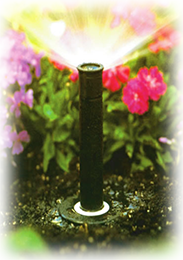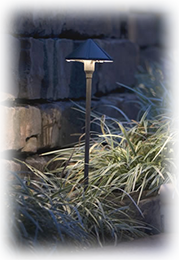FAQs
“An irrigation and/or landscape lighting system should be considered a home improvement and an investment, and can potentially increase the value and curb appeal of your property.”
Sprinkler Questions

When to water is the most frequently asked question. Whether you have a new or established lawn and are wanting to install a new sprinkler system or upgrade an existing one, there is new technology, such as a rain sensor that can suspend irrigation, measure rainfall amount and calculate how much to adjust the watering schedule to prevent either over- or under-watering.
Our new water based technology in controllers use a small, on-site moisture and temperature gauge that gathers weather data and sends it to the controller, which then uses that information to calculate a new watering schedule daily. There is also a wireless version for homeowners to upgrade existing controllers.
When should I water newly seeded lawns?
Newly seeded, sodded or less than 1 year old lawns will need water every 2-3 days all summer long.
How often should established lawns be watered?
Toby Tobin recommends “For a green, healthy lawn all summer long, your lawn needs 1.5-2” of water per week. If it doesn’t rain, you need to water and use a rain gauge to check water levels. Do not over water! This can lead to disease. Kentucky bluegrass, fescue and other cool season grasses don’t have to be watered to stay alive in the summer except during extreme drought (but they don’t look good!). Cool season lawns turn brown and go dormant until cooler fall weather. During droughts apply 1 inch of water every 3 weeks to keep the grass crowns hydrated and in good condition or the lawn will die out.”
Be efficient. Too much water robs grass of oxygen and wastes water in the street.
Not enough water can lead to foundation issues like cracks, leaks and loss of expensive landscape plants, especially during hot months.
If your grass has shades of brown or doesn’t spring back after stepping on it, it has heat stress and needs watering. It needs 1.5 – 2” a week during the hot days.
When is the best time to water?
Early morning to 7:00 a.m. During these hours the lawn is already wet from dew. Watering after 7:00 a.m. extends the periods the lawn is wet. The goal is to minimize the amount of time the lawn stays damp.
What’s the next best time to water?
Noon – 2:00 p.m. This is likely the most popular time for homeowners without sprinkler systems to water. Watering at these hours allow the lawn to dry out in the morning and again before nightfall.
What’s the worst time to water?
DO NOT WATER between 7:00 a.m. – noon or between 2:00 p.m. – during the nighttime hours. Watering during these hours extends the amount of time the grass is wet, thus tremendously increasing the chance for disease problems.
What if I can’t water during the “best hours”?
If you’re not able to water during the recommended hours of the day, then water heavily on the weekends or don’t water at all. A dormant lawn is healthier than a diseased lawn.
How much should I water in the fall?
If the existing lawn is green, its root system is still growing. So, if the weather has been dry, grass will need watering. Lawns require less water during the cooler, shorter days of fall because there is less moisture lost to evaporation.
Newly laid sod should be watered thoroughly in advance of winter to ensure good contact between the thin layer of roots and the subsoil. After all leaves have been raked, soak the new lawn an inch or more and then try to keep people and machinery from compacting it.
Based on normal fall weather conditions, plan to turn your sprinkler system off in early to mid-November as established grass has usually gone dormant by then.
Will I use more water with a sprinkler system than if I keep watering myself?
No. You’ll conserve water and use less! Your properly programmed system will not over water and can’t forget to turn itself off. Your timer controller can even be fitted with a wireless moisture sensor that will tell it not to turn on if it’s raining. The system can also be easily adjusted to apply less water during the off peak seasons.

Lighting Questions
How do I replace the lamps in my lighting system?
Once we install a lighting system, any lamp that burns out within the first year is replaced at no charge. If your system was installed over a year ago, most of your lamps will probably need to be replaced. To ensure that your system continues to operate effectively and efficiently, we offer an annual renewable maintenance program. If you service your own system, we offer lamps at competitive prices.
Can I get a maintenance program?
Just as an automobile will run better and last longer with regular tune-ups and oil changes, a lighting system will perform better with regular routine maintenance. Calcium stains from sprinklers, insect invasion, leaves, mulching and other build-up can quickly degrade or even cover the output from fixtures. Our annual renewable maintenance program includes a complete cleaning of fixtures.
Plantings may also have overgrown current fixture locations, or fixtures may have been knocked out of place by gardeners or pedestrians. Proper pruning, repositioning and minor repairs ensure light goes where it is needed.
A lighting system can alter due to landscaping changes, weather conditions or the addition of a new patio, deck or water feature. While we’re servicing your lighting system, we may recommend changes to the overall design.
Renewed annually, our maintenance program is designed to keep your system operating properly, illuminate all areas originally designed to light, plus help to protect your investment and satisfaction over the life of the installation.
I want to improve the look of my home by installing a lighting system. Can I do it myself?
A design to enhance your property is very important. A good design includes fixtures that illuminate landscaping and architectural features that aren’t seen at night. Fixtures are spaced to eliminate shadows and dark areas that can cause safety and security concerns. A poor design will result in glares and shadows causing more harm than good.
There are quality differences in products from manufacturers found in the “big box” do-it-yourself stores. That’s why we only partner with established, reputable companies with UL®1838 tested listings, quality constructed products.
We will install lighting fixtures properly so they are adjusted to eliminate lamp glare, wire and controls are hidden and transformers are installed at their proper height.
Your yard and landscaping should not be disturbed with a quality installation.
Lowest Price Question
I want to have a sprinkler or lighting system installed, why shouldn’t I choose the lowest price? All systems do the same thing – right?
There are major differences in how sprinkler systems water the grass and lighting systems illuminate landscape and architectural features. Things to look for include:
- Design – A proper design is the foundation for a quality installation. For irrigation, a good design includes properly spaced sprinklers that throw water from sprinkler to sprinkler (head-to-head coverage), proper positioning of the valve boxes on the property, and a properly placed controller. A poor design can result in brown patches, or cause the need to over-water by trying to compensate for the poor design. A lighting system should be designed so it doesn’t cause shadows and lamp glare from poorly adjusted fixtures or it can affect how safely you can walk around your property, and unwanted light shining in a window.
- Product – There is a large range in product quality within the industry. Most products will work properly for the first season. But the true mark of a quality product is its longevity and ease of use. That is why we partner with reputable manufacturers.
- Installation – A proper installation by a professional should look as though nothing was disrupted. There can be slight damage to grass yards, but it’s kept to a minimum by a quality installer. Sprinklers should not be exposed and valve boxes should be flat. Lighting wire should not stick up out of the ground and transformers should be installed to meet all safety standards.
- Overall – A quality sprinkler or lighting system may cost a little more up front, but the savings in water, energy-efficiency, time and headaches will be worth it.
“The value of experience is not expensive, it’s priceless!”
For questions about new or existing commercial/residential sprinkler and lighting systems, please complete the Contact Us form or call 913-967-6910.